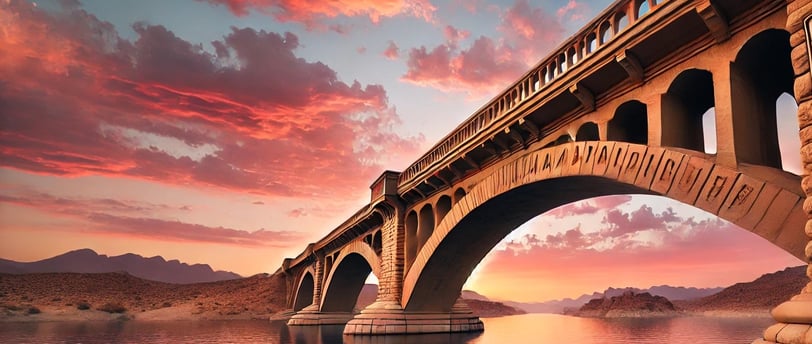The Engineering Feat of the London Bridge in Arizona
The London Bridge in Lake Havasu City is more than just a tourist attraction; it is a marvel of engineering and logistical achievement. From the careful disassembly in London to the meticulous reassembly in Arizona, it showcases how engineering is not simply about construction but also about preservation, adaptation, and creative problem-solving.
SCIENCE
Camapa Editorial
11/2/20243 min read


The London Bridge, now spanning a canal of Lake Havasu in Arizona, is a remarkable engineering endeavor that showcases not only the art of civil construction but also the intricacies of dismantling, transporting, and reassembling a historical structure. What was once an iconic element of London's urban landscape now serves as a testament to engineering prowess and innovation in a vastly different setting, over 5,400 miles from its original location.
Background and Motivation
The original London Bridge, completed in 1831 and designed by engineer John Rennie, was no longer suitable for the demands of a modern metropolis by the mid-20th century. Increasing weight from vehicular traffic and the structural limitations of the bridge prompted the City of London to seek a solution. Ultimately, it was decided that the bridge would be sold, dismantled, and relocated. In 1968, American entrepreneur Robert P. McCulloch purchased the bridge as a promotional investment to draw attention to his development at Lake Havasu City, Arizona.
Dismantling the Bridge
Dismantling a granite bridge with historical significance required precise planning to preserve the integrity of its individual components. Each of the 10,276 granite blocks was meticulously numbered to ensure accurate reconstruction. The method involved disassembling the bridge stone by stone, using cranes and scaffolding to delicately remove each block. A systematic numbering scheme, akin to a giant jigsaw puzzle, facilitated the reassembly. Engineers faced the challenge of not just preserving the visual appeal of the structure but also ensuring that no block was damaged or misplaced during transport.
The stones were transported by ship through the Panama Canal and then by truck to Arizona. This transcontinental journey required careful logistical planning, including considerations for the weight distribution of the cargo, preventing structural fatigue during shipment, and ensuring compliance with shipping regulations.
Reconstruction in Arizona
Reassembling the bridge in a new environment required significant modifications to the original structure. While the exterior granite blocks were reassembled according to Rennie’s original design, the underlying support system was rebuilt with a more modern approach to ensure the bridge’s structural stability. Unlike its original setting, where it had been supported by a series of arches over the River Thames, the reconstructed London Bridge in Arizona spans a concrete base over a canal specially dug for this purpose.
Modern construction techniques were used to supplement the historical elements. A reinforced concrete framework was utilized to provide the necessary structural integrity, ensuring that the bridge could withstand increased loads and seismic activity that might affect Arizona. This combination of traditional materials with modern reinforcements illustrates a sophisticated engineering approach to adaptation. The bridge now effectively balances both aesthetic preservation and functionality in an unfamiliar environment.
Challenges and Engineering Solutions
One of the primary engineering challenges was the stark contrast in the climatic conditions between London and Arizona. The arid desert environment of Lake Havasu presents extreme temperatures that can exceed 110°F in summer. Granite, although a resilient material, expands and contracts with temperature variations. The original design did not account for the level of thermal stress typical of a desert climate, necessitating adjustments to accommodate expansion and prevent cracking. Expansion joints and flexible mortar were introduced to allow for movement without compromising the bridge’s integrity.
The foundations were also significantly re-engineered to address the geographical differences. In London, the bridge's piers were submerged in the Thames River, whereas in Arizona, a man-made canal was constructed. This required a firm understanding of soil mechanics to ensure stability. Engineers incorporated deep footings to prevent settlement in the loose, sandy soil of the Lake Havasu area. The integration of deep caissons ensured a secure foundation capable of carrying the bridge's considerable weight.
The Significance of the Relocation
The reassembly of the London Bridge in Arizona stands as an impressive example of adaptive reuse, where an existing structure was given a new life while maintaining its historical character. The project combined the precision of historical preservation with the advances of modern civil engineering. For engineers, the success of this project highlights the potential for ingenuity when addressing the complexities of relocation, cultural preservation, and adaptation to new environments.
This feat also speaks to the universality of engineering principles, transcending national borders and illustrating how historical infrastructure can be integrated into new settings. By combining old-world craftsmanship with contemporary engineering techniques, the London Bridge now serves as a symbol of human capability—showing that even monuments with storied histories can be adapted, preserved, and made relevant again in a modern context.
Conclusion
The London Bridge in Lake Havasu City is more than just a tourist attraction; it is a marvel of engineering and logistical achievement. From the careful disassembly in London to the meticulous reassembly in Arizona, it showcases how engineering is not simply about construction but also about preservation, adaptation, and creative problem-solving. The project serves as an enduring example of how traditional infrastructure can be given a second life, demonstrating the intricate balance of art and science that underpins the discipline of civil engineering.
Camapa Editorial
camapaeditorial@gmail.com
© 2024. All rights reserved.
Our mission at Camapa Editorial is to explore, analyze, and present insights within these fields in a way that both educates and inspires further inquiry. Whether delving into groundbreaking scientific discoveries, examining the intricacies of athletic performance and emerging sports, or exploring the multifaceted world of entertainment, Camapa Editorial aims to be a trusted guide in your journey of learning and exploration.
